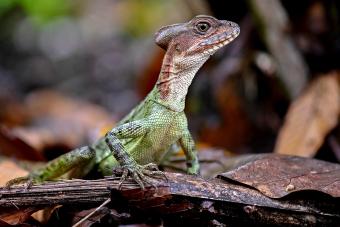
Reptiles and amphibians are two separate types of animals with very different lifestyles. They both have unique characteristics that set them apart, but there are some similarities, as well. So, how do you tell the difference between reptiles and amphibians? Let's take a look!
What is a Reptile?
Reptiles are a group of animals that include snakes, lizards, turtles, and crocodiles. They are cold-blooded -- meaning they rely on the external environment to regulate their body temperatures -- and usually live in warm climates. Reptiles have scales on their skin instead of hair or feathers. They shed their skin to grow larger as they age.
Reptiles are distantly related to birds and dinosaurs. Reptiles can be found in deserts, forests, rivers, and oceans around the world. Most reptiles lay eggs that hatch into young reptiles called hatchlings or "babies." Most egg-laying reptile parents abandon their nest and the baby reptiles before the eggs hatch. Many reptiles are carnivores, or meat eaters, who hunt and kill other animals for food.
Examples of Reptiles
Lizards are cold-blooded reptiles that have scales, lay eggs, and possess claws. They are found worldwide. Examples include chameleons, geckos, iguanas, monitors, and skinks.
Turtles are reptiles because they have a backbone, and they're ectothermic (cold-blooded). They also have scales, but not all reptiles do. However, turtles do have a shell that protects their bodies, which is unique to turtles and tortoises. They are found worldwide and can live in saltwater or freshwater environments. Examples include box turtles, snapping turtles, and terrapins.
What is an Amphibian?
An amphibian is a creature that has both an aquatic larval stage and an adult stage. Most amphibians also have gills when in their larval stage, which they use to breathe in water. Later, in their adult stage, most amphibians develop lungs and can breathe air.
This means that they can live on both land and in water, and this is where their name comes from: "amphibios" means "two lives." An amphibian's life cycle goes like this:
- They hatch from eggs, like birds or reptiles do.
- Then they go through a period called the larval stage, during which they have gills and live in water.
- After this period, they lose their gills and become more like small adults with lungs.
Amphibians possess two pairs of kidneys, one on each side of the body cavity. In general, amphibian skin is moist or dry and covered with mucous glands or waxy secretions that enable them to retain water; it may be smooth or have small granular bumps called tubercles. They have no hair, fur, scales or feathers on their bodies, but many mucous glands, which help keep them moist when they are out of water for long periods of time, such as during their unique version of hibernation.

Examples of Amphibians
The axolotl is a salamander that can regenerate limbs, and is commonly kept as a pet. The axolotl is also known for its ability to heal itself from amputated limbs by growing new ones.
The caecilian is a legless amphibian that has adapted to live in water. It has a long body and no limbs. The caecilian is found in Central and South America. It's also known as the "blind worm" or "worm snake."
Frogs are one of the most recognizable types of amphibians because they have long legs and smooth skin. Frogs are found on every continent except Antarctica, where they would freeze! They're known for their ability to make noises with their vocal cords, known as "calling."
The salamander gets its name from the Greeks: "Salamander" means "fire lizard" in their language. They have the ability to grow back lost limbs over time -- something that's still happening today with some species, such as the axolotl. Some salamanders have lungs but also retain gills into adulthood, so they can breathe underwater; some species can even live on land without being able to breathe properly there!
Learn About Different Species
There's so much more to reptiles and amphibians than the stereotypical snakes, lizards, and toads that are most frequently feared or shunned. These animals are vital parts of their ecosystems, and many of them are fascinatingly diverse. If you'd like to get to know these creatures a little better, do some of your own research and you'll discover species you never knew existed.







